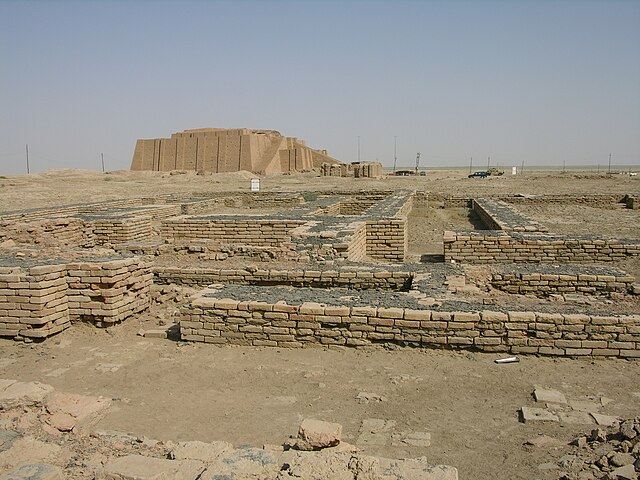Enheduanna was the entu (high) priestess of the moon god Nanna (Sīn) in the Sumerian city-state of Ur in the reign of her father, Sargon of Akkad. She was likely appointed by her father as the leader of the religious group at Ur to cement ties between the Akkadian religion of her father and the native Sumerian religion.
Enheduanna, high priestess of Nanna (c. 23rd century BCE)
Enheduanna's father, Sargon of Akkad, founded the Akkadian Empire in the 24th century BCE
The Disk of Enheduanna, discovered by Leonard Woolley shows the high priestess standing in worship as what has been interpreted as a nude male figure pours a libation
The ruins of the Giparu (front), the temple complex where Enheduanna served as an EN priestess
Sin or Suen (Akkadian: 𒀭𒂗𒍪, dEN.ZU) also known as Nanna (Sumerian: 𒀭𒋀𒆠 DŠEŠ.KI, DNANNA) was the Mesopotamian god representing the moon. While these two names originate in two different languages, respectively Akkadian and Sumerian, they were already used interchangeably to refer to one deity in the Early Dynastic period. They were sometimes combined into the double name Nanna-Suen. A third well attested name is Dilimbabbar (𒀭𒀸𒁽𒌓). Additionally, the moon god could be represented by logograms reflecting his lunar character, such as d30 (𒀭𒌍), referring to days in the lunar month or dU4.SAKAR (𒀭𒌓𒊬), derived from a term referring to the crescent. In addition to his astral role, Sin was also closely associated with cattle herding. Furthermore, there is some evidence that he could serve as a judge of the dead in the underworld. A distinct tradition in which he was regarded either as a god of equal status as the usual heads of the Mesopotamian pantheon, Enlil and Anu, or as a king of the gods in his own right, is also attested, though it only had limited recognition. In Mesopotamian art, his symbol was the crescent. When depicted anthropomorphically, he typically either wore headwear decorated with it or held a staff topped with it, though on kudurru the crescent alone served as a representation of him. He was also associated with boats.

Impression of the cylinder seal of Ḫašḫamer, ensi (governor) of Iškun-Sin c. 2100 BCE. The seated figure is probably king Ur-Nammu, bestowing the governorship on Ḫašḫamer, who is led before him by Lamma (protective goddess). Sin himself is indicated in the form of a crescent.
Symbols representing Sin (center), Ishtar (left) and Shamash (right), as depicted on the upper half of a kudurru of Meli-Shipak II.
A relief of Kušuḫ (right), the Hurrian moon god, from Yazılıkaya
A relief depicting the offering of a libation to the Anatolian moon god Arma (right).








